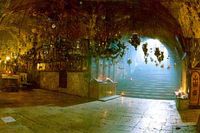Category:Relics of Mary (subject)
According to Christian (and Islamic) traditions, Relics of Mary of Nazareth are preserved in several locations, notably, the Cathedral of Prato and Ephesus (see Mary of Nazareth).
< Life of Mary of Nazareth : Expulsion of Joachim from the Temple -- Annunciation to Anne and Joachim -- Birth of Mary -- Girlhood of Mary (Education of the Virgin, Presentation of Mary at the Temple) -- Marriage of Mary and Joseph -- Annunciation to Mary -- Visitation of Mary -- Birth of Jesus -- Adoration of the Shepherds -- Adoration of the Magi -- Circumcision of Jesus -- Presentation of Jesus at the Temple -- Massacre of the Innocents -- Flight into Egypt -- Jesus among the Doctors -- Death of Joseph of Nazareth -- Wedding at Cana -- Jesus' True Relatives -- Hometown Rejection -- Crucifixion of Jesus -- Resurrection of Jesus -- Ascension of Jesus -- Gathering of the Twelve at Jerusalem -- Christian Pentecost -- Death and Assumption of Mary -- Relics of Mary of Nazareth >
Overview
Christian tradition maintains that Mary's body was assumed to heaven. Consistently, as in the case of Jesus, only certain bodily parts (such as her milk, hair, or similar) were said to be preserved. The majority of relics of Mary are made of her belongings, such as the clothes she wore or the house where she lived. None of them can claim any historicity.
Milk of Mary (at Montevarchi)
The relic of Mary's Holy Milk (Sacro Latte di Maria) is preserved in the Collegiata di San Lorenzo, Montevarchi [Italy]. The narrative is that the relic was presented to the city of Montevarchi by the king of France in 1266. At the beginning the relic was housed at the Church at San Ludovico before moving to the Collegiata. Pope Leo X (in 1515) and many rulers visited over the centuries the relic, which is still today venerated in the church.
Hair of Mary
The tradition says that Mary put three hairs in a letter she sent in the year 42 to the inhabitants of Messina, Italy; see also below Letter of Mary.
Holy Hair of Mary, at Messina, Sicily, Italy
Holy Hair of Mary, at Palmi, Calabria, Italy
!n 1575 the plague hit Messina, causing more than 40,000 fatalities. During the plague, the city of Palmi hosted many refugees and helped those who had remained in Messina. As a token of gratitude, the city of Messina presented to the city of Palmi one of the three hairs that according to an established legend the Virgin Mary had put in a letter she sent to the inhabitants of Messina in 42. In 1582 the relic was solemnly transported in a boat from Messina to Palmi. Ever since the shrine of the Holy Hair has been carried in procession once a year in August, together with the painting of "Our Lady of the Sacred Letter". Recently, since 2009, the shrine has been permanently displayed in a chapel at the Concattedrale di San Nicola.
The Girdle of Mary
The tradition says that Mary died in the presence of all Apostles but Thomas. When Thomas arrived he saw the Virgin ascending to heaven and was given her Girdle to confirm his vision. There are several competing narratives about what happened next. According to one version of the legend, Thomas carried the relic to India where he died a martyr. In 394 A.D. together with the coffin of Thomas, the Girdle of Mary was also moved back from India to the West. Another version says that the relict was kept in Jerusalem until it was moved to Constantinople where it was originally deposited in the Chalcoprateion church. Then the relic was transferred by the Emperor Leo to the Vlachernae church (458). During the reign of Leo VI ‘the Wise’ (886-912), it was taken to the Imperial Palace.
The churches which today claim possession of the relic, include:
- the Cathedral of Saint Stephen in Prato, Tuscany [Italy]
- St. Mary's Soonoro Church in Holms [Syria]
- the Trooditissa Monastery, near Platres [Cyprus] -- The orthodox monastery is dedicated to the Virgin Mary.
- the Vatopedi Monastery, Mount Athos [Greece] -- When in October-November 2011 the relic went to Russia for a monthlong tour, more than two million of people venerated it.
- the Collégiale Notre-Dame at Le Puy-Notre-Dame [France]
- the Collégiale Notre-Dame de Délivrance at Côtes-d'Armor, Bretagna [France]
- the Catedral de Santa Maria in Tortosa, Terragona/Catalogna [Spagna];
- Bruton Abbey in Somerset [England].
Clothes of Mary
- Nôtre Dame de Chartes [France] -- The Church Preserves the veil, tunic, or chemise of Mary. It is the oldest and most famous relic of the kind. It is said it belonged to Charlemagne. Later Charles II (the Bald) gave it to the Cathedral at Chartres/France in 877.
- Aix La Chapelle, Aachen [Germany] -- The church Preserves the shroud of Mary. The relic is exhibited once every seven years.
- Mary's shoes were venerated at the Cistercian Abbey Maria Ophoven. However they were stolen in 1826 and never found again.
The Ring of Mary
- Cathedral of St Lawrence, Perugia, Umbria [Italy] -- The legend says that the ring came to Italy from Jerusalem in 985. A Jewish merchant gave it to a family in Chiusi [Italy]. A series of miracles surrounding the ring convinced the people of the town of the authenticity of the ring and around 989 the relic was presented to the local Church of Santa Mustiola. Around 1251 the ring was moved to the Cathedral of San Secondiano, and in 1420 to the Church of San Francesco. In 1477 a German monk stole the ring to bring it to Germany, but a miraculous fog forced him to leave it in Perugia. The theft caused a war between the two nearby cities, until Pope Sixtus IV intervened and confiscated the ring. However, his successor Innocent VIII returned the ring to Perugia, where it is still today preserved in a Chapel in the Cathedral.
- Weihenlinden/Germany -- The wedding ring
Houses of Mary (at Nazareth, Loreto, and Ephesus)
- (1) Nazareth, Israel -- The House in which Mary was born, and lived at Nazareth is said to be identified in 336 by Saint Helena who ordered a basilica to be erected over it. The Basilica of the Annunciation at Nazareth contains in its lower level the Grotto of the Annunciation, believed to be the remains of the original childhood home of Mary.
- (2) Loreto, Marche, Italy -- The narrative maintains that in 1291 the angels carried the House of Mary from Nazareth first to Tersatto-Trsat, near Rijeka [Croatia], and then, in 1294, to its current location in Loreto [Italy]. Loreto became an important center of pilgrimage and a splendid sanctuary was build to contain the relic. The Shrine of the Holy House (Basilica della Santa Casa) is still today one of the most popular sanctuaries in Italy.
- (3) Ephesus, Turkey -- The ruins of the house where Mary supposedly lived in Ephesus with the apostle John were first "identified" on October 18, 1881 by the Abbé Julien Gouyet, based on the description of the visionary Anne Catherine Emmerich. In 1891 Sister Marie de Mandat-Grancey was responsible for acquiring, restoring and preserving Mary's House and transforming it into a major pilgrimage site. Today the site is venerated by Muslims as well as Christians. Three Popes visited the Shrine--Paul VI (July 26, 1967), John Paul II (November 30, 1979), and Benedict XVI (November 29, 2006).
The (Empty) Tomb of Mary
- Mary's Tomb, Kidron Valley, Jerusalem -- A sarcophagus in a grotto is believed to be the original burial place of Mary. The Greek Orthodox Church of Jerusalem is in possession of the shrine, sharing it with the Armenian Apostolic Church. The Syriacs, the Copts, and the Abyssinians have minor rights. Muslims also have a special place for prayer (the mihrab).
The Letter of Mary
- Messina [Italy] -- A reliquary was housed in the Cathedral, containing a letter allegedly written by the Virgin Mary to the City of Messina in the year 42. The original is believed to be lost. Its actual author was Constantine Laskaris in the fifteenth century.
External links
- [ Wikipedia]
This category currently contains no pages or media.













